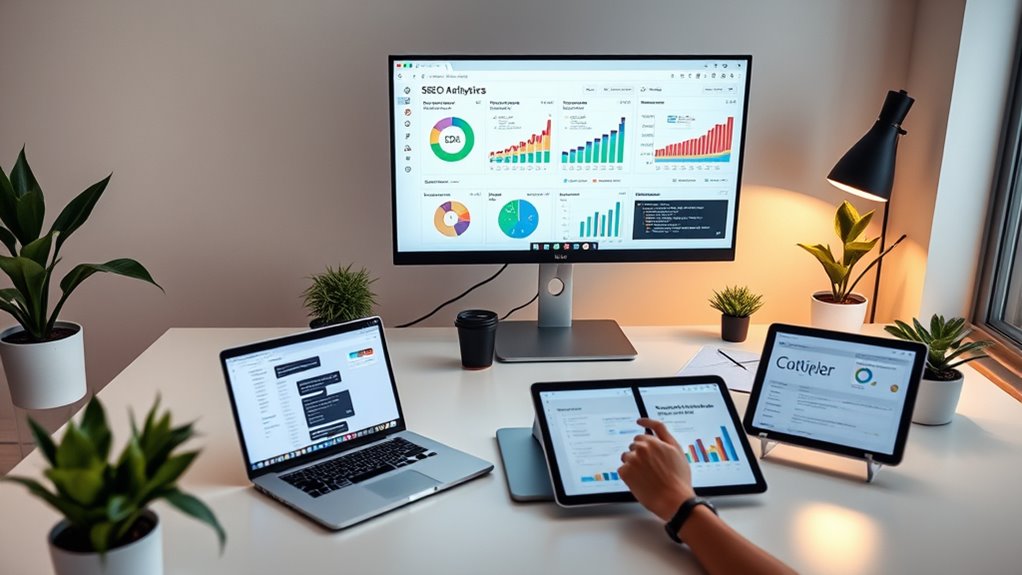In 2025, a successful holistic SEO strategy ties together compelling, intent-driven content, technical site optimization, and a seamless user experience. You’ll need to adapt to voice search and semantic understanding, ensuring your site loads fast and works well on mobile devices. Focus on structured data and automation to stay ahead of industry shifts. By continuously analyzing performance and adjusting your approach, you’ll stay competitive—keep exploring to uncover how all these elements connect for maximum impact.
Key Takeaways
- Develop a user-intent-focused content strategy using semantic search and audience segmentation to address diverse needs effectively.
- Optimize site speed, mobile responsiveness, and structured data to enhance technical SEO and improve user experience.
- Incorporate engaging design elements and intuitive interfaces to boost user engagement and reduce bounce rates.
- Leverage data analytics and industry insights for continuous content and technical performance improvements.
- Utilize AI and automation tools to streamline SEO workflows, personalize user experiences, and stay ahead of evolving algorithms.
Understanding the Evolving Search Landscape in 2025

As search engines become smarter and user behavior shifts, understanding the evolving search landscape in 2025 is essential for your SEO strategy. Voice search continues to grow, making natural language queries more common. People prefer speaking their questions rather than typing, which means optimizing for conversational keywords is crucial. Semantic search also plays a fundamental role, as search engines now interpret intent and context rather than just keywords. This shift emphasizes the importance of creating content that addresses specific user needs and questions holistically. To stay ahead, you must adapt your SEO efforts to these changes, focusing on how users ask questions and ensuring your content aligns with their search intent. Additionally, understanding search performance metrics such as click-through rates and bounce rates can help you refine your strategy for better engagement. Recognizing these trends helps you craft a strategy that remains effective in this dynamic environment. Incorporating insights from content optimization techniques can further enhance your ability to meet evolving search demands. Keeping up with AI-driven content creation advancements allows you to produce relevant content faster and more effectively.
Building a Content Strategy That Aligns With User Intent

To construct an effective content strategy, you need to focus on understanding your audience’s needs and preferences. Creating relevant content that matches their search intent ensures your messaging resonates and drives engagement. By aligning your goals with user intent, you can deliver value and improve your chances of ranking higher in search results.
Identifying Audience Needs
How can you guarantee your content genuinely meets your audience’s needs? Start by using audience segmentation to divide your audience into specific groups based on demographics, interests, and behavior. Then, conduct thorough keyword research to understand what users are searching for and their intent. This combination helps you identify core needs and tailor content accordingly. Consider this example:
| Segment | Common Search Intent | Relevant Keywords |
|---|---|---|
| Beginners | How-to guides, basic info | “beginner SEO tips” |
| Experienced Users | Advanced strategies | “technical SEO techniques” |
| Local Audience | Local services, maps | “SEO services near me” |
Additionally, understanding butter making techniques can inform how you craft content that is both practical and engaging for your audience. Recognizing effective content optimization strategies ensures your material remains relevant and accessible. Incorporating insights about eye patch benefits can also help you develop content that appeals to readers interested in skincare and aesthetic improvements.
Crafting Relevant Content
Building on your understanding of audience needs, crafting relevant content requires aligning your messaging with the specific intent behind user searches. Start with thorough keyword research to identify what your audience is looking for and how they phrase their queries. Use this data to inform your content creation, ensuring each piece addresses the core questions or problems users aim to solve. Incorporate content personalization by tailoring your messaging to different segments, making it more engaging and useful. Focus on delivering clear, actionable information that resonates with user intent. When your content precisely matches what users seek, you improve engagement, reduce bounce rates, and boost your chances of ranking higher in search results. Additionally, understanding the importance of color accuracy, you can tailor your content to emphasize how precise color reproduction enhances the overall viewing experience. Ultimately, relevant content that aligns with user intent builds trust and authority in your niche.
Aligning Goals and Intent
Aligning your goals with user intent is essential for developing an effective content strategy. When you understand search intent, you can create content that genuinely meets user needs and drives goal alignment. Focus on the different types of search intent—informational, navigational, transactional, and commercial—to tailor your approach. By aligning your content with these intents, you ensure relevance and increase engagement. To do this effectively, consider these key ideas:
- Identify primary user goals behind each search
- Match content types to search intent (e.g., guides for informational)
- Optimize keywords for goal-specific queries
- Continuously analyze and adjust based on user behavior
- Incorporate retirement planning concepts to better address user questions and improve content relevance.
- Recognize how tea accessories and merchandise can be integrated into content to enhance user experience and meet specific intent.
This alignment helps your content resonate, improves rankings, and boosts conversions by addressing what users truly seek.
Optimizing Technical Foundations for Better Visibility

To improve your website’s visibility, start by optimizing site speed so visitors don’t bounce. Make sure your site is mobile-friendly, providing a seamless experience across devices. Implement structured data to help search engines better understand your content and boost your chances of rich snippets. Additionally, ensuring your site incorporates elements of cozy textiles and rustic decor can enhance user engagement and dwell time. Incorporating insights from Water Parks, such as their seasonal events and attractions, can also inform your content strategy to attract and retain visitors. Staying informed about AI detection methods can help you create authentic content that resonates with your audience, improving overall engagement. Understanding how self watering plant pots work can inspire engaging content that appeals to plant enthusiasts seeking low-maintenance gardening solutions. Exploring Fokos and related topics can also provide unique content angles to diversify your website’s offerings.
Site Speed Optimization
Site speed plays a crucial role in how search engines evaluate your website’s quality and relevance. A faster site improves user experience, reduces bounce rates, and boosts your rankings. To optimize your site speed, focus on reducing page load times and server response times. You can achieve this by:
- Compressing images to decrease load time
- Minimizing code and scripts that slow down rendering
- Leveraging browser caching for repeated visitors
- Choosing a reliable hosting provider with quick server response
These strategies ensure your website loads swiftly and efficiently, which search engines reward with better visibility. Remember, a slow website not only frustrates visitors but can also harm your rankings. Prioritize site speed optimization as a key component of your holistic SEO approach.
Mobile Responsiveness Enhancements
Since mobile devices now account for a significant portion of web traffic, ensuring your website is mobile-responsive is essential for better visibility and user engagement. Focus on implementing a responsive design that adapts seamlessly to various screen sizes, providing a smooth experience across all devices. Incorporate touch-friendly features, such as larger buttons and easily navigable menus, so users can interact effortlessly. Test your site on multiple devices to identify and fix any responsiveness issues promptly. Prioritize fast loading times on mobile to reduce bounce rates. By optimizing your technical foundation with responsive design and touch-friendly features, you improve user experience and send positive signals to search engines, boosting your visibility in mobile search results.
Structured Data Implementation
Have you ever wondered how search engines understand the content of your website? Structured data implementation, through schema markup, helps clarify your content’s meaning. By adding schema markup, you enable search engines to generate rich snippets, making your listings more attractive and informative. This improves your visibility and click-through rates. To get started, focus on:
- Marking up reviews, products, and events
- Using JSON-LD format for easy integration
- Validating your schema with testing tools
- Keeping your structured data updated and accurate
Implementing structured data correctly guarantees your site communicates effectively with search engines, helping you stand out in search results. Rich snippets created with schema markup can notably boost your visibility and drive more traffic to your website.
Enhancing User Experience to Boost Engagement and Rankings

Ever wondered why some websites keep visitors engaged while others see high bounce rates? The key lies in enhancing user experience through strategic design. Interactive design invites users to actively participate, making their visit memorable and encouraging longer stays. Visual storytelling captures attention quickly, conveying your message compellingly without overwhelming the visitor. When your site offers a seamless, intuitive interface, visitors find it easier to navigate and enjoy their journey. This engagement not only reduces bounce rates but also signals to search engines that your site provides value, boosting your rankings. Focusing on user-centric design principles can significantly improve visitor satisfaction and retention. Additionally, incorporating sustainable design practices can appeal to environmentally conscious users and differentiate your site in a competitive landscape. Developing a positive emotional connection with visitors fosters trust and loyalty, which can lead to repeat visits and higher engagement. Implementing accessible design features ensures that your content is reachable by users with diverse needs, broadening your audience. Moreover, integrating voice-over narration techniques, similar to those used in engaging National Geographic ads, can further enhance content appeal and accessibility. By doing so, you foster trust, increase engagement, and improve your overall SEO performance.
Leveraging Data and Analytics for Continuous Improvement

To stay ahead in SEO, you need to continuously analyze your website’s performance data. This helps you identify trends, uncover opportunities, and refine your strategies. Use predictive modeling to forecast future performance, enabling proactive adjustments. Regular competitor benchmarking reveals industry shifts and highlights areas where you can outperform rivals. By tracking key metrics, you can pinpoint what’s working and what’s not. Consider these approaches:
- Monitoring traffic sources and conversion rates
- Analyzing keyword rankings with real-time data
- Applying predictive models for trend forecasting
- Comparing your performance against competitors
- Incorporating insights from Glycolic Acid benefits to better understand how consistent, data-driven improvements can lead to skincare success. Staying informed about mental health support systems can also enhance your overall content strategy by addressing user concerns related to well-being. Additionally, understanding the importance of gear and equipment safety protocols can improve your content accuracy and reliability when discussing industry standards. Regularly reviewing your website’s comfort and support solutions can reveal areas for technical optimization that improve user engagement and satisfaction.
Leveraging these insights ensures your SEO efforts adapt to changing algorithms and user behaviors, driving ongoing growth and maintaining your competitive edge.
Integrating AI and Automation in Your SEO Workflow

Building on your data-driven insights, integrating AI and automation streamlines your SEO workflow, making it more efficient and responsive. AI integration helps you analyze large datasets quickly, identify opportunities, and optimize content at scale. Automation workflows handle routine tasks like keyword tracking, site audits, and reporting, freeing up your time for strategic decisions. By leveraging AI-powered tools, you can personalize user experiences and improve search rankings more effectively. These technologies enable real-time adjustments based on changing algorithms or user behavior, ensuring your SEO efforts stay agile. Incorporating AI and automation into your process isn’t just about efficiency—it’s about gaining a competitive edge through smarter, faster, and more precise optimization. This integration ultimately enhances your entire holistic SEO strategy.
Monitoring Trends and Adapting Your Holistic Approach

Staying ahead in SEO requires continuously monitoring industry trends and adjusting your strategies accordingly. Emerging algorithms can change how search engines rank content, so staying informed is essential. To keep your holistic approach effective, focus on:
- Tracking updates in search engine algorithms and adjusting content and technical SEO.
- Analyzing data from multiple channels to understand cross channel branding impacts.
- Refining user experience based on evolving UX best practices.
- Incorporating new tools and techniques to stay ahead of competitors.
Frequently Asked Questions
How Can Small Businesses Implement a Holistic SEO Strategy Effectively?
To implement a holistic SEO strategy effectively, start with a thorough content audit to identify strengths and gaps. Develop a solid keyword strategy that aligns with your target audience’s needs. Focus on optimizing your website’s technical aspects and user experience. Consistently monitor your progress and adjust accordingly. This approach guarantees all SEO elements work together, helping your small business improve visibility, attract more visitors, and boost conversions over time.
What Role Does Social Media Play in a Comprehensive SEO Plan?
Ever wondered how social media influence could be the secret weapon in your SEO plan? You might be surprised to learn that social media plays a essential role in content amplification, boosting your visibility and engagement. By sharing your content strategically, you can attract backlinks, increase traffic, and enhance your search rankings. Don’t underestimate the power of social media—it’s a critical piece in your all-inclusive SEO puzzle that can propel your business forward.
How to Measure the ROI of Holistic SEO Efforts Accurately?
You can measure the ROI of your holistic SEO efforts by focusing on conversion tracking and KPI alignment. Set clear, specific KPIs that reflect your overall goals, such as organic traffic, engagement, and conversions. Use analytics tools to monitor these metrics regularly, ensuring your efforts directly contribute to desired outcomes. This way, you accurately assess how your integrated strategies impact your business, giving you a clear picture of your SEO ROI.
Are There Specific Tools Recommended for Integrated SEO Management in 2025?
You’ll want to explore tools that leverage AI integration and data analytics for integrated SEO management in 2025. Platforms like SEMrush, Ahrefs, and Moz now incorporate AI-driven insights, helping you analyze content, technical health, and UX performance seamlessly. These tools enable you to make data-backed decisions, optimize strategies holistically, and stay ahead of competitors. Embrace AI-powered analytics to streamline your SEO efforts and achieve measurable ROI efficiently.
How Can Organizations Ensure Team Collaboration Across Content, Technical, and UX Teams?
To guarantee team collaboration across content, technical, and UX teams, you should foster open cross-department communication and emphasize shared goal alignment. Regular meetings, collaborative project management tools, and clear documentation help everyone stay on the same page. Encourage transparency and mutual understanding, so all teams work toward common SEO objectives. This approach strengthens teamwork, boosts efficiency, and ultimately enhances your website’s performance in search rankings.
Conclusion
By weaving together content, tech, and UX, you craft a symphony that guides search engines and users alike. Think of your SEO strategy as a garden—nurture each element, adapt to changing seasons, and watch your efforts bloom. In this evolving landscape, your holistic approach becomes the compass, steering you toward sustained growth. Stay attentive, innovate boldly, and let your digital journey flourish like a well-tended tree reaching toward the sky.










